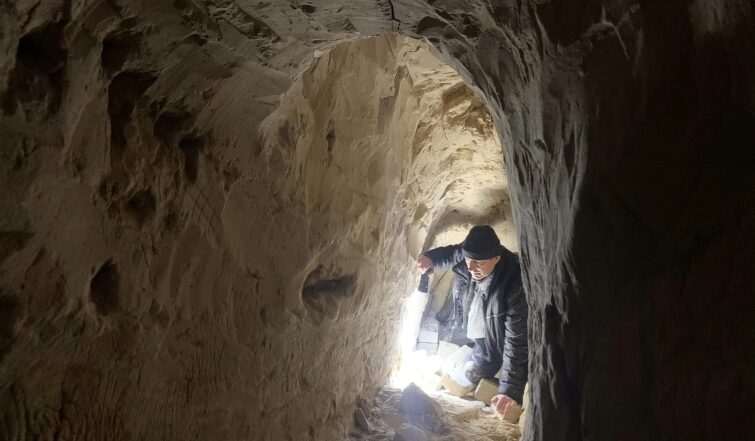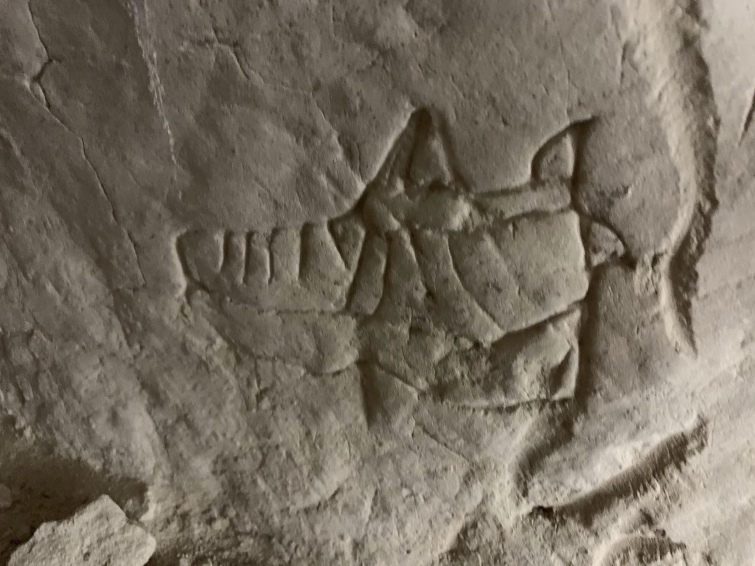Kyiv activists rescue discovered ancient medieval cave

Photo from the archive of Dmytro Perov
Activists in Kyiv found the ancient Ascension Cave next to an abandoned house in the historical center of Kyiv.
Dmytro Perov, an expert at the Center for Urban Development, reported this.
According to archaeologists, it is a cave from the time of Kyivan Rus [Ukraine's ancestor country] with rock paintings. It miraculously survived, but constructing a new residential complex may destroy it forever.
For several months, the Kyiv City Council has been actively lobbying for the transfer of the land plot to the developer. An abandoned, dilapidated building at 25 Voznesenskyi Uzviz is located on it. It was privatized, and now the site is planned to be put into operation.
Dmytro Perov works at the Center for Urban Development. His responsibilities include analyzing decisions of the Kyiv City Hall and preparing documents for relevant decisions and documents. He says that Voznesenskyi Uzviz Street is a path connecting the historical areas of Old Kyiv and Podil. Urban and city planning began here in Kyivan Rus' times and became more active in the 18th century. During the XIX-XX centuries, the street was actively developed, mostly low-rise buildings, but most of it has been lost.
The activist noted that the commissioning documents were submitted to the Kyiv City State Administration for consideration several times. His attention was drawn to the house address: Voznesenskyi Uzviz, 25. His great-great-grandmother Daria Volosova lived in this house at the beginning of the 20th century. It was a family three-story manor house.

"In 1919, the communists came and made a 'sealing'; they settled the family in one room on the top floor and occupied the rest of the rooms. My grandmother and great-grandmother lived there until 1979," says Dmytro.
They were evicted in 1980 because their house fell under the decree on the liquidation of obsolete housing. They wanted to "clean up" Kyiv on the eve of the 1980 Olympics because part of the competition was held in the capital of the Ukrainian SSR. But since childhood, Dmytro was told about his relatives and the estate. And they mentioned the existence of an ancient cave.
"Grandmother said about that house that there was some cave. But it was more like a children's legend. That somewhere there, in the mountain, there was a big stone house, and next to it, an ancient cave. No one knew where it was located. We lived in a different area, but I never explored the estate or the plot near it," the activist notes.
A few weeks ago, he invited his friends to the old homestead to find the cave he had heard about since childhood.
"It took about half a day to search; we explored the area around the house and found a loophole hidden behind the wall," says the man with delight.
He and his friends were lucky enough to find a complex of 4 caves, the entrance to 2 is silted up.
"We climbed on our knees because you can't stand full height. This is because the cave has silted up. It is long, about 35 meters, and the walls are decorated with rock paintings.
So I started looking for an archaeologist who confirmed the historical value of this cave," Dmytro adds.
He says animistic images of animals and graffiti from the later Varyaz period were found on the walls. For example, the outline of the rune Algiz (or "chicken's foot") can be seen on one of the walls of the complex. The ancient Varangians used this drawing as a symbol of protection, a charm, a symbol of life. The following weekend, the cave was shown to professor of archeology Timur Bobrovskyi. He works in the reserve, Sofia Kyivska.
"The professor was skeptical, saying that the cave in the center of Kyiv is a fantasy. We brought him and showed him the cave. Then Mr. Timur asked us to wait while he made some notes. More than 3 hours passed, and it was getting dark when the professor came out. He was amazed by the treasure in the center of Kyiv," says the activist.
According to Timur Bobrovskyi's preliminary estimates, this cave dates back to the time of Kyivan Rus or may even belong to the pre-Christian period. The specialist emphasizes the need to continue research, as a large complex of monastic buildings of the 14th and 16th centuries is nearby.
"Existing historical sources regarding this origin and neighboring sources have not been found. However, according to the parameters, location, and nature of the vaults, the cave can be classified as a special group of historical Kyiv dungeons," says expert Bobrovskyi.
The archaeologist believes that the Ascension Cave resembles the Smordyn Cave of the 17th century or the Vryazka Cave in the Kyiv Pechersk Lavra.
So far, Dmytro Perov has collected several historical and archaeological expert conclusions. After the corresponding appeal, the issue of transfer of the plot for development was removed from the agenda of the Kyiv City State Administration.


















































